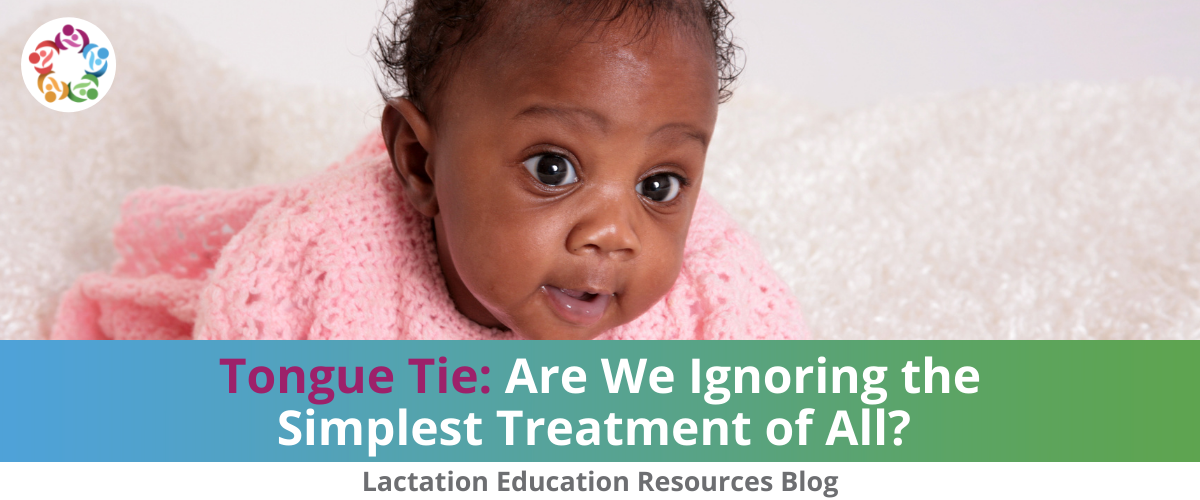Tongue Tie: Are We Ignoring the Simplest Treatment of All?

When you’re working with a baby with tongue tie, what treatment modalities do you recommend?
There are certainly a lot to choose from.
You might suggest the family try chiropractic care or infant massage, a visit with a speech language pathologist, or a consultation with a pediatric dentist or another practitioner who offers surgical release.
Or a family might try all of the above.
In fact, Myrte van Lonkhuijsen, MA, IBCLC, a veteran lactation consultant in private practice outside Amsterdam, frequently sees clients who have been referred to between three and eleven different types of providers to help their tongue-tied baby.
That number made van Lonkhuijsen start asking a question. With all of these modalities, what if we’re missing the most obvious treatment of all?
When a baby has a tie, breastfeeding is often difficult–it’s part of the problem to be solved.
But van Lonkhuijsen was convinced that breastfeeding could instead be a gentle, simple therapy for babies with TOTs.
Operating on the assumption that breastfeeding itself can help a baby with tethered oral tissues strengthen, heal, and thrive, van Lonkhuijsen began working with a concept she calls “Concorde Latch.”
Titled after an airplane with an adjustable nose angle, this technique got its name because it involves (among many other things) manipulating the angle of the parent’s nipple as it enters the baby’s mouth.
In a nutshell, the Concorde Latch approach involves:
Working with baby’s spinal alignment and posture. Position the baby in a specific way that encourages relaxation of the jaw, a wider open mouth, and great range of motion for the lower jaw and tongue.
A different way to hold the breast. Support the breast into the baby’s mouth throughout the feed, with fingers at the baby’s lower jaw, often even touching the chin, to remove weight and pressure from the lower jaw.
A focus on parent-baby teamwork and connection. Parent uses breathwork and close attunement to their baby to work together on breastfeeding, using micro-adjustments to achieve the best latch.
With this approach, instead of a hurdle to overcome, Lonkhuijsen sees time at the breast become a “flexible and adaptable training facility.”
Assisted by techniques that make it easier for them to succeed, babies get more milk for less effort–and are motivated to keep trying. In the process, they strengthen and learn to use their orofacial muscles and tongue optimally with a wonderful reward–milk.
van Lonkhuijsen is quick to point out that she does not believe Concorde Latch can solve all tethered oral tissue problems–and she acknowledges that other treatments, including surgical release, are often part of the answer.
But, she says, not all tongue ties are “created equal.”
While some clearly require surgical intervention, many that lactation care providers encounter are less clear. And, surgical treatment, bodywork, and other modalities are not always available or affordable for every family.
In cases where surgical treatment is not clearly indicated, or other techniques are out of reach, the benefits of breastfeeding can prove accessible and promising.
And, Concorde Latch techniques can be used effectively alongside surgical release, both before and after surgery.
van Lonkhuijsen thinks there is another question worth asking as well.
At a time when some studies are suggesting that one in seven babies needs surgical tongue tie revision in order to nurse, and when as many as 11 providers are sometimes involved in the treatment, she wonders, “If breastfeeding requires so many professionals to get it all working, are we making breastfeeding demanding and vulnerable? It is so easily broken? Or is there more resilience to the system than we dare to believe?
“What if we imagine that breastfeeding is a nonfragile aspect of our biology, our survival equipment?” she continues, “and that drinking at the breast itself facilitates optimal orofacial development? And, that perfection isn’t needed … but that good enough might just be good enough?”
Interested in learning more about how breastfeeding can be used as therapy in babies with tethered oral tissues?
Enroll in LER’s “Full Spectrum TOT Conference.”
van Lonkhuijsen’s course, “Tongue Tie: Can Breastfeeding be Part of the Solution?” is included.
This conference is a two-part, in-depth look at tethered oral tissues through the eyes of two experienced IBCLCs and a pediatric dentist, all specializing in tethered oral tissues. Sign up today and complete the conference modules at your own pace.

When you’re working with a baby with tongue tie, what treatment modalities do you recommend?
There are certainly a lot to choose from.
You might suggest the family try chiropractic care or infant massage, a visit with a speech language pathologist, or a consultation with a pediatric dentist or another practitioner who offers surgical release.
Or a family might try all of the above.
In fact, Myrte van Lonkhuijsen, MA, IBCLC, a veteran lactation consultant in private practice outside Amsterdam, frequently sees clients who have been referred to between three and eleven different types of providers to help their tongue-tied baby.
That number made van Lonkhuijsen start asking a question. With all of these modalities, what if we’re missing the most obvious treatment of all?
When a baby has a tie, breastfeeding is often difficult–it’s part of the problem to be solved.
But van Lonkhuijsen was convinced that breastfeeding could instead be a gentle, simple therapy for babies with TOTs.
Operating on the assumption that breastfeeding itself can help a baby with tethered oral tissues strengthen, heal, and thrive, van Lonkhuijsen began working with a concept she calls “Concorde Latch.”
Titled after an airplane with an adjustable nose angle, this technique got its name because it involves (among many other things) manipulating the angle of the parent’s nipple as it enters the baby’s mouth.
In a nutshell, the Concorde Latch approach involves:
Working with baby’s spinal alignment and posture. Position the baby in a specific way that encourages relaxation of the jaw, a wider open mouth, and great range of motion for the lower jaw and tongue.
A different way to hold the breast. Support the breast into the baby’s mouth throughout the feed, with fingers at the baby’s lower jaw, often even touching the chin, to remove weight and pressure from the lower jaw.
A focus on parent-baby teamwork and connection. Parent uses breathwork and close attunement to their baby to work together on breastfeeding, using micro-adjustments to achieve the best latch.
With this approach, instead of a hurdle to overcome, Lonkhuijsen sees time at the breast become a “flexible and adaptable training facility.”
Assisted by techniques that make it easier for them to succeed, babies get more milk for less effort–and are motivated to keep trying. In the process, they strengthen and learn to use their orofacial muscles and tongue optimally with a wonderful reward–milk.
van Lonkhuijsen is quick to point out that she does not believe Concorde Latch can solve all tethered oral tissue problems–and she acknowledges that other treatments, including surgical release, are often part of the answer.
But, she says, not all tongue ties are “created equal.”
While some clearly require surgical intervention, many that lactation care providers encounter are less clear. And, surgical treatment, bodywork, and other modalities are not always available or affordable for every family.
In cases where surgical treatment is not clearly indicated, or other techniques are out of reach, the benefits of breastfeeding can prove accessible and promising.
And, Concorde Latch techniques can be used effectively alongside surgical release, both before and after surgery.
van Lonkhuijsen thinks there is another question worth asking as well.
At a time when some studies are suggesting that one in seven babies needs surgical tongue tie revision in order to nurse, and when as many as 11 providers are sometimes involved in the treatment, she wonders, “If breastfeeding requires so many professionals to get it all working, are we making breastfeeding demanding and vulnerable? It is so easily broken? Or is there more resilience to the system than we dare to believe?
“What if we imagine that breastfeeding is a nonfragile aspect of our biology, our survival equipment?” she continues, “and that drinking at the breast itself facilitates optimal orofacial development? And, that perfection isn’t needed … but that good enough might just be good enough?”
Interested in learning more about how breastfeeding can be used as therapy in babies with tethered oral tissues?
Enroll in LER’s “Full Spectrum TOT Conference.”
van Lonkhuijsen’s course, “Tongue Tie: Can Breastfeeding be Part of the Solution?” is included.
This conference is a two-part, in-depth look at tethered oral tissues through the eyes of two experienced IBCLCs and a pediatric dentist, all specializing in tethered oral tissues. Sign up today and complete the conference modules at your own pace.
By accepting you will be accessing a service provided by a third-party external to https://www.lactationtraining.com/
